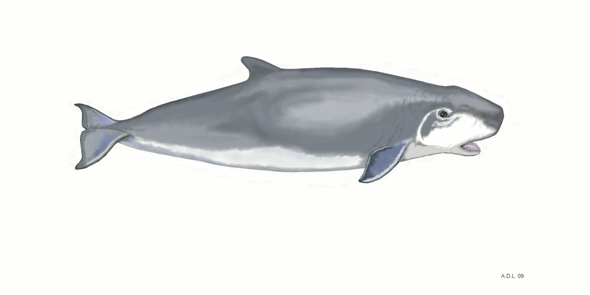Species Index


Key Facts
Length: Up to 3.5 metresRange: Tropical and temperate waters
Threats: Marine litter, pollution, hunting, acoustic disturbance
Diet: Squid, cuttlefish and some fish
Pygmy Sperm Whale
Latin: Kogia breviceps
Physical Description
The pygmy sperm whale is a small robust-bodied whale that can measure 3.5 metres in length. They have certain features in common with the sperm whale: the head is of a similar blunt shape and contains the spermaceti organ; this organ is filled with a waxy substance thought to be important in sound production and echolocation. The lower jaw is narrow and contains all of the teeth. In contrast with the sperm whale, the pygmy sperm whale has a small curved dorsal fin. Colouration is a steel grey on the dorsal surface with an almost-white belly. There is a pale coloured, crescent-shaped ‘false gill’ marking behind each eye. Circular scars are common and are caused by squid bites, whilst tooth rake marks arise from fighting with other pygmy sperm whales and shark predation.
Habitat and Distribution
Pygmy sperm whales favour continental shelf and slope regions and deep water. They inhabit waters as far south as New Zealand, whilst Scottish waters represent its most northerly limit, thus sightings in Hebridean waters are extremely rare.
Behaviour
Pygmy sperm whales are not known for aerial acrobatics or bow riding. This elusive whale makes deep dives and is submerged for long periods. Upon surfacing, the blow is usually inconspicuous and the surfacing pattern is a slow roll, exposing the back and dorsal fin but not raising the tail fluke. The pygmy sperm whale has a sac in the lower intestine that contains about 12 litres of a dark coloured, viscose liquid that is expelled to deter predators; a similar mechanism is used by cephalopods (cuttlefish, squid and octopus).
Food and Foraging
Pygmy sperm whales strand relatively frequently, particularly in the United States, and analysis of their stomach contents has revealed that their diet is composed of squid, cuttlefish, crabs and some fish.
Status and Conservation
There are no population estimates for the pygmy sperm whale, although they are not thought to be globally endangered. There is some subsistence hunting in Japan and Indonesia, but this species has never been a target for commercial whalers. Current threats include the accumulation of toxic pollutants in whale tissue and organs, entanglement in fishing nets and marine litter, and noise disturbance. As a squid eating cetacean, pygmy sperm whales may swallow plastic bags mistaken for prey. Ship strikes may also occur when the whale is logging motionless at the surface. Pygmy sperm whales are protected under UK and EU law, principally under Schedule 5 of the Wildlife and Countryside Act 1981, the Nature Conservation (Scotland) Act 2004 and by the 1992 EU Habitats and Species Directive.





